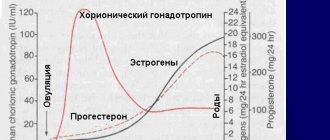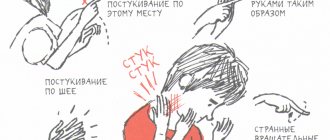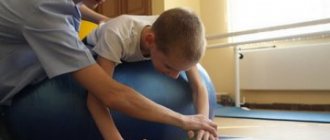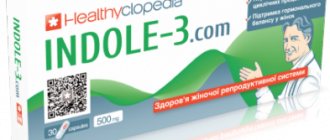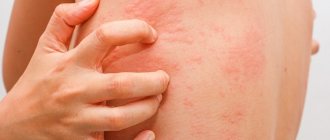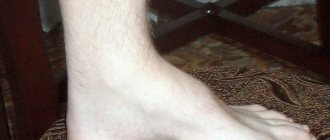Head tremors are rhythmic vibrations or shaking of the head of an involuntary nature. Such twitching manifests itself in the form of trembling or sweeping oscillatory swaying. They are directed back and forth or from side to side. This type of tremor occurs at any age, even in infants. Head tremor can be physiological (benign) or pathological.
Benign head tremors are characterized by involuntary fluctuations at rest, during vigorous activity, or due to severe stress. It is characterized by: episodic attacks, the presence of long periods of remission and the absence of increased manifestations.
With physiological head tremor, a person often does not even feel its manifestation.
Pathological head tremor occurs as a result of a number of ailments. It is not painful, but causes significant discomfort when performing simple daily functions.
Causes of head tremors
Cervical dystonia
A characteristic sign of cervical muscular dystonia associated with impaired neck muscle tone is isolated head tremor. It occurs when maintaining a stationary position or at the beginning of a motor act (postural-kinetic), has a frequency below 7 Hz and varying amplitude. In some patients, tremors are present at rest. Dystonic tremor intensifies when turning and tilting the head in the direction opposite to the affected muscles. The patient's performance of reverse movements or corrective gestures (touching the chin) leads to the disappearance of trembling.
Essential tremor
Among the causes of head tremor, one of the main places is occupied by the essential process. Benign tremors, the mechanism of which remains unknown, can begin at any age. The disease debuts with tremors of the hands, the head is involved later. Symmetrical trembling with essential tremor is postural in nature or increases during movement, especially at its end point (terminal). Head tremors intensify with excitement and take the form of nodding (“yes-yes”) or rocking (“no-no”) movements.
The tremor frequency varies from 6 to 10 Hz in different patients. Over time, a resting tremor may develop, which is especially pronounced in a sitting position, but does not disappear with the onset of movement, being a continuation of the postural one. Other neurological disorders in essential tremor are usually absent, sometimes minor symptoms of ataxia, plastic hypertonicity (the “jackknife” phenomenon), and weakened facial expressions are observed. Some patients are diagnosed with mild cognitive impairment.
Parkinsonism
Classic parkinsonian tremor is a tremors at rest when the muscles are completely relaxed. Its source is recognized as the central oscillators in the basal ganglia. The neck muscles are involved simultaneously with the arms or a little later. Parkinson's disease is characterized by a “yes-yes” or “no-no” head tremor that disappears with movement. The picture is complemented by slowness, a shuffling gait, and a “supplicant pose.” Muscle tone changes (the “gear wheel” symptom), and the cognitive sphere suffers.
Multiple sclerosis
Tremor is considered a typical and common symptom of multiple sclerosis. Usually it is bibrachial, that is, it affects adjacent segments - one or both arms and the head. Trembling is explained by damage to the cerebellum and its connections, therefore it usually has an intentional nature, occurs during movement and intensifies when a goal is achieved. But people with multiple sclerosis may also experience other types of it, for example, head tremors at rest, caused by the presence of a focus of demyelination in the thalamus, basal ganglia or frontal lobes.
Multiple sclerosis, accompanied by tremors, has a number of clinical features. It is characterized by an earlier onset and a predominance of cerebellar disorders at the onset. The advanced stage of the pathology is manifested by imbalance in the form of static and dynamic ataxia, and oculomotor disorders. Pyramid symptoms (muscle weakness, spasticity) and sensory disorders are much less pronounced.
Metabolic encephalopathies
As a symptom of metabolic disorders, head tremor is included in the picture of generalized trembling hyperkinesis, involving the muscles of the arms, neck and torso. It is observed at the stage of subcompensation and progresses as the brain is damaged. Hypoxic-ischemic perinatal encephalopathy in children is caused by complicated pregnancy and childbirth (asphyxia, intrauterine infections, injuries). It can manifest itself as low-amplitude tremors, pathological head positions, clonic convulsions, which are combined with suppressed reflexes.
The symptoms of hepatic encephalopathy are quite varied. With chronic intoxication, tremors of the head and hands (including “flapping”) and spasms of facial muscles develop. The pathology is characterized by slow convulsive and fast intermittent movements (choreoathetosis), ataxia, and cognitive impairment. Severe uremia in chronic kidney disease is manifested by postural-kinetic tremors, rapid muscle twitching (myoclonus), and convulsive attacks. Any metabolic encephalopathy occurs against the background of impaired consciousness.
Paraneoplastic syndromes
In the clinic of opsoclonus-myoclonus syndrome, tremor of the head, trunk and limbs is a sign of a fairly advanced process. This is an autoimmune paraneoplastic syndrome associated with the development of malignant neoplasms. Trembling is caused by damage to the cerebellar system, combined with decreased muscle tone, dysarthria, and drooling, but the most typical signs of the disease are opsoclonus and myoclonus.
Opsoclonus is understood as chaotic multidirectional eye movements, which are accompanied by convulsive twitching of the muscles of the limbs and trunk, static or dynamic ataxia. The second pathognomonic sign of the syndrome is polymorphic myoclonus, which takes the form of short muscle twitches of varying amplitude. Their predominant localizations are lips, eyelids, trunk and limbs.
Hereditary diseases
The cause of head tremors can be hereditary diseases of a neurodegenerative or demyelinating nature. Hyperkinesis is caused by changes in cerebral structures that control voluntary movements and maintain muscle tone and posture. Damage to the cerebellum, extrapyramidal system and corticospinal connections is observed in the following conditions:
- Olivopontocerebellar atrophy.
The first sign of the disease is cerebellar ataxia. It is accompanied by intention tremor, head tremors, and dysarthria. In later stages, Parkinson-like syndrome, paresis of facial muscles, and mental disorders are observed. - Pelizaeus-Merzbacher disease.
The disease is characterized by a triad of symptoms - horizontal, vertical and rotational eye movements (nystagmus), head tremors, and coordination problems. Subsequently, muscle tone increases, speech slows down, and intelligence decreases. Late stages are characterized by hyperkinesis, parkinsonism syndrome, and profound dementia. - Ataxia with vitamin E deficiency ( AVED ).
Patients present with progressive cerebellar ataxia with absent tendon reflexes. Head tremor, pyramidal insufficiency, and dysarthria often occur. Characterized by polyneuropathy, skeletal deformities and sleep disorders. - Wilson-Konovalov disease.
The trembling form is manifested by static and postural tremor of the head, similar to rocking, and the upper extremities. Choreiform hyperkinesis and bulbar disorders (impaired speech, swallowing) may be detected. The progression of the disease leads to an increase in rigidity or muscle hypotonia, and mental disorders.
Prion diseases
Head tremor in those suffering from kuru, a rare prion disease, a type of spongiform encephalopathy, is a fairly characteristic symptom. It manifests itself as severe trembling or intermittent movements, often combined with spasm of the facial muscles (“sardonic smile”). The pathology begins with dizziness and fatigue; as the neurodegenerative process progresses, the ability to control voluntary motor acts is lost, ataxia, hyperkinesis (choreoathetosis), and myoclonus appear.
Causes of pathology
Head tremors occur due to stressful situations, when the body is overworked and exhausted. This phenomenon occurs due to the use of medications. If the symptom is observed in adolescents and the elderly, then this deviation is usually benign in nature, and heredity in this case does not play any role.
In exceptional cases, there is a possibility of tremors spreading completely over the entire body.
Spasmodic torticollis is a pathological abnormality associated with a nervous disease caused by a characteristic abnormal position of the head.
If an adult experiences this trouble, this may be a consequence of the following changes:
- Multiple sclerosis.
- Kidney and liver diseases.
- Respiratory disorders.
- Deviations in the functioning of the midbrain.
- Poisoning with salts of heavy metals.
- Hyperthyroidism, which occurs when the thyroid gland malfunctions.
- If there is pathology of the central nervous system.
- For osteochondrosis of the spine, namely the cervical region.
- If a person has an alcohol, toxic or drug addiction.
- With genetic predisposition.
Newborns may also experience involuntary head shaking due to injuries to the nervous system.
Causes of tremor in infants:
- During development, fetal hypoxia was noted.
- For birth injuries.
- In case of stressful conditions of the mother while waiting for the baby.
- With an increased content of norepinephrine, a hormone produced in the adrenal glands.
Fetal hypoxia can be caused by:
- Wrapping the baby in the umbilical cord.
- Fetoplacental insufficiency.
- If a woman had polyhydramnios.
- During rapid labor.
- For infectious lesions of the uterine cavity.
Premature babies also have a shaky head quite often.
If teenagers have a shaking head, possible causes may include:
- Information overload. For example, stress may be caused by upcoming exams.
- Experiences on the personal front.
Such stress can be accompanied by impaired coordination of the motor system, aggressiveness and poor sleep.
Diagnostics
Identifying head tremor is not difficult, since the symptom is clearly visible during a routine examination. A much more difficult task facing the doctor is determining the cause of the trembling. Taking into account the etiological heterogeneity of the pathological condition, a neurologist has a number of additional methods in his arsenal that provide significant assistance in the diagnostic process:
- Laboratory.
In a biochemical blood test, the area of interest includes kidney and liver tests, and acute phase indicators. Diagnosis of Wilson-Konovalov disease involves determining plasma concentrations of copper and ceruloplasmin, AVED syndrome - tocopherol; in multiple sclerosis, immunoglobulins in the cerebrospinal fluid are examined. - Neuroimaging.
Accurate verification of structural changes in the brain is the prerogative of MRI of the brain. The technique allows us to identify pathological foci (demyelination, neurodegeneration, atrophy), establish their localization and prevalence. PET-CT can be used to determine the functional activity of cerebral structures. - Neurophysiological.
EMG allows you to record a tremorogram with further assessment of the amplitude-frequency characteristics of the tremor. To analyze the safety of pathways, the method of evoked potentials (somatosensory, auditory, visual) is used. Paroxysmal neuronal activity can be detected using EEG.
To determine the causes of hyperkinesis, molecular genetic methods are of particular importance. Suspicion of paraneoplastic syndrome requires an active search for a malignant process with ultrasound of the kidneys, liver and other organs. When a head shake is detected, differential diagnosis should be made between the most common dystonic, essential and parkinsonian tremor, not forgetting other conditions.
Causes
In most cases, doctors cannot figure out why some people develop cervical dystonia and others do not. In some cases, however, there is a connection between the development of spasmodic torticollis and injuries to the head, neck or shoulder. Some medications, such as certain psychotropic drugs or antiemetics, may cause cervical dystonia in some people.
Risk factors
Risk factors for developing cervical dystonia include:
- Age. While people of any age can develop the disease, even children, it most often begins between the ages of 40 and 70.
- Floor. Women are more likely to develop spasmodic torticollis than men.
- Family history. If a close family member has cervical dystonia or any other type of dystonia, then the patient has a higher risk of developing the disease.
- Complications: Some people who first develop cervical dystonia go on to develop similar symptoms in neighboring regions, such as the shoulder or face. Additionally, the disability and pain that can be caused by cervical dystonia can lead to depression.
Treatment
Conservative therapy
The completeness and effectiveness of treatment for head tremor depends on eliminating the cause, but since the etiology of many diseases remains incompletely understood, the main directions of therapy remain symptomatic and pathogenetic. The situation is complicated by the fact that head tremors, unlike those localized in the hands, are less amenable to pharmacotherapy. The main groups of medications include:
- Beta blockers.
Non-selective β-blockers (propranolol, nadolol, sotalol) have shown their effectiveness in essential and other types of tremor, which is due to the inhibition of sympathetic influences. Targeted drugs (atenolol, metoprolol) can also be used. - Anticonvulsants.
A negative or insufficient response to β-blockers requires the use of anticonvulsants. Primidone, gabapentin, and topiramate have the ability to suppress the generation of tremor. Temporary improvement can be observed under the influence of clonazepam, alprazolam. - Antiparkinsonian.
Treatment of parkinsonian head tremor is usually carried out with levodopa, which, if ineffective, is treated with dopamine receptor agonists (pramipexole) or amantadine. Static tremors respond better to such therapy than action tremors.
Before actively treating head tremor, pay attention to the exclusion of stimulants from the diet (coffee, strong tea), and the abolition of certain medications. In addition to pharmacotherapy, botulinum therapy is considered an important area. Most often, injections are performed to treat dystonic head tremor. Physical methods include kinesiotherapy, wearing cervical collars, exercise therapy and massage.
Treatment methods
Treatment is selected individually, taking into account the cause of the pathology, concomitant diseases, the patient’s age and personal characteristics. In general, head tremor is difficult to treat and requires complex treatment. Only the benign form is usually easily cured with sedatives.
Self-medication is dangerous with complications!
Attention
Despite the fact that our articles are based on trusted sources and have been tested by practicing doctors, the same symptoms can be signs of different diseases, and the disease may not proceed according to the textbook.
Pros of seeing a doctor:
- Only a specialist will prescribe suitable medications.
- Recovery will be easier and faster.
- The doctor will monitor the course of the disease and help avoid complications.
find a doctor
Do not try to treat yourself - consult a specialist.
Drug therapy for pathological tremor does not have significant effectiveness, but is included in the general treatment complex. Sedatives and anticonvulsants are mainly used. Medicines are selected individually exclusively by a doctor; self-medication is strictly not recommended.
Vitamins are also prescribed in the form of intramuscular injections, and others.
Additional relaxation techniques are recommended:
- breathing exercises;
- exercises at a calm pace (yoga, Pilates, etc.);
- various relaxation and meditation techniques;
- visiting the swimming pool;
- medicinal baths , etc.
It will be useful to attend sessions with a psychologist in order to improve the emotional background, reduce excitement and anxiety.
For tremor caused by osteochondrosis, treatment is aimed mainly at eliminating the main cause, i.e. the disease itself. Recommended:
- drug therapy;
- massage;
- physiotherapy;
- physical therapy , etc.
With successful treatment of osteochondrosis, the trembling disappears on its own.
Children's head tremors usually go away on their own, without special treatment. If the disorder is prolonged, the pediatric neurologist prescribes therapy. It includes light sedatives, herbal baths, massage, and special gymnastics.
Non-standard approach
In Eastern medicine, finger yoga is widely practiced, the asanas of which are called mudras. If you have a head tremor, you need to do “exercises” daily, consisting of two exercises:
- Wind mudra. It is necessary to press the tip of the index finger to the base of the thumb (meaning the fingers of one hand). Use your thumb to help your index finger, lightly pressing it from above. The main task of the unused fingers is to remain relaxed and as straight as possible.
- Mudra of "life". Three fingers should be joined together: the thumb, ring and little finger. The index and middle fingers remain straight.
You can practice mudras throughout the day, setting aside some time for this in the office, in line, or on public transport. But at least one “charging” must be complete, that is, carried out:
- in a calm, secluded environment;
- in a relaxed state of mind (work and personal worries should be put out of your head for a while);
- with complete focus on the desired goal.
You can combine mudra classes with yoga training. Both of these systems are aimed at calming the mind and normalizing the functioning of all body functions.
Head tremor is an unpleasant, but surmountable phenomenon. The sooner measures are taken to get rid of this pathology, the more noticeable the result will be. Therefore, the first thing you need to do is go to the doctor, and then decide whether to take medications or limit yourself to folk remedies.
Hand tremors: causes, treatment, medications, list of medications
The following drugs are used to treat hand tremors:
- anticonvulsants (“Primidone”, “Clonazepam”);
- carbonic anhydrase inhibitors (“Diakarb”);
- non-selective beta blockers (“Anaprilin”);
- beta-blockers (“Nadolol”), etc.
The appropriateness of using a particular drug is determined by doctors at the Yusupov Hospital individually for each patient, depending on the cause that provoked the appearance of hand tremors.
Here you can get advice from leading doctors in Russia, undergo diagnostics, establish a diagnosis and undergo a course of effective treatment aimed at eliminating hand tremors, and, accordingly, the disease that provoked the occurrence of tremors of the upper extremities. You can make an appointment by calling the Yusupov Hospital.



